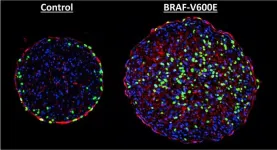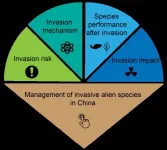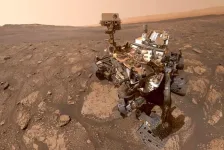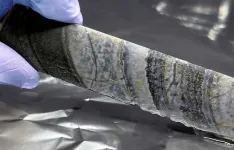(Press-News.org) DURHAM, N.C. – Biomedical engineers at Duke University have demonstrated that one of the most dangerous mutations found in skin cancers might moonlight as a pathway to mending a broken heart.
The genetic mutation in the protein BRAF, a part of the MAPK signaling pathway that can promote cell division, is one of the most common and most aggressive found in melanoma patients. In a new study, researchers show that introducing this mutation to rat heart tissue grown in a laboratory can induce growth.
Repairing cardiac muscle after a heart attack is the “holy grail” of heart research, complicated by the fact that heart tissue does not regenerate on its own. One potential strategy would be to persuade heart muscle cells to divide by safely delivering a therapeutic gene to patients and fully controlling its activity in the heart.
The new study, appearing online January 24 in the journal Science Advances, lays important steps in finding ways to achieve this goal.
“Mature heart muscle cells do not typically divide, so we thought we’d need an especially strong genetic mutation to convince them to multiply,” said Nenad Bursac, professor of biomedical engineering at Duke. “MAPK is a well understood pathway that, when mutated, can be pretty aggressive at inducing proliferation in cancers, which is why we chose to look into it.”
In the study, Bursac and PhD student Nicholas Strash studied neonatal rat heart cells grown within a 3D hydrogel environment. Developed by the laboratory over more than a decade, the hydrogel environment provides the cues to grow and mature cells into adult-like heart muscle tissues, where cell division naturally stops.
Then, to try to get the muscle to divide and grow again, the researchers infected it with a virus loaded with a mutated BRAF gene. Following its normal behavior, the virus inserted the mutated gene into the cells, causing it to become a part of the cells’ DNA. The researchers then introduced a drug that caused the mutated BRAF genes to activate.
As with skin cancer, once activated, the mutant genes caused the heart muscle cells to enter DNA synthesis — the first step in cell division and growth. But there were also drawbacks.
“Once the cells started entering into their multiplication phase, they also began disassembling the machinery that allows them to contract and pump blood when in the heart,” Strash said. “It caused the tissue as a whole to lose about 70% of its contractile strength, which is pretty dramatic. One reason for this is that almost all cells in the tissue got infected by the virus.”
The results are both exciting and revealing. Any potential therapeutic that can get adult heart cells to proliferate is cause for optimism. But with the accompanying loss of strength, the dosage and duration of gene activation needs to be precisely controlled – thus there’s much to do before any potential use in human patients.
For starters, a different delivery system would have to be applied that can deliver the genes to the correct cells in a way that clinicians can fully control. Methods such as lipid nanoparticles and short-living viruses are two approaches currently being developed, but both still have a ways to go before they could be applied for heart regeneration in humans.
The other major hurdle is finding a way to jump start heart tissue regeneration without causing the tissue to lose strength. Based on the timing of cellular mechanisms, the researchers believe there may be a window in which the mutated gene activity could be stopped after the replication begins, but before the contractile machinery is affected in a large portion of the heart. Or there may be an opportunity to administer a second therapeutic that could prompt the cells to rebuild the dismantled pumping machinery after proliferation.
Moving forward, the researchers are planning to study how this approach works in the hearts of live animals and compare it to their lab-tested results. Working with live animals will also provide a better understanding of what other genes and processes are activated by the mutated BRAF gene, and whether proliferation could be independently activated without functional decline to efficiently promote healing.
“The heart essentially does not have primary cancers, and it’s almost unique that it doesn’t,” Bursac said. “Introducing this cancer mutation in the heart is obviously an engineered outcome that doesn’t happen naturally. Studying it in lab-grown tissues is a great step toward understanding what this entire signaling pathway does within the heart, which could have benefits beyond regenerative therapies.”
The research was supported by the National Institutes of Health (U01HL134764, R01HL164013, 5T32HD040372, 1F31HL156453, 1F31HL162460), the Translating Duke Health Initiative and a Foundation Leducq grant (15CVD03).
CITATION: “Time-dependent Effects of BRAF-V600E on Cell Cycling, Metabolism, and Function in Engineered Myocardium,” Nicholas Strash, Sophia DeLuca, Geovanni L. Janer Carattini, Yifan Chen, Tianyu Wu, Abbigail Helfer, Jacob Scherba, Isabella Wang, Mehul Jain, Ramona Naseri, and Nenad Bursac. Science Advances, Jan. 24 2024. DOI: 10.1126/sciadv.adh2598
END
Harnessing skin cancer genes to heal hearts
A common powerful mutation found in melanoma can push heart muscle cells to multiply in laboratory models of heart tissue
2024-01-24
ELSE PRESS RELEASES FROM THIS DATE:
Special Feature calls attention to biological invasion research in China
2024-01-24
This month, the Ecological Society of America spotlights the challenge posed by invasive alien species in China with the release of a Special Feature, “Management of Biological Invasions in China,” in the latest issue of its journal Ecological Applications.
Accelerating rates of biological invasion have led to growing concerns about the destructive impacts of invasive alien species, or IAS, on the environment and human societies. This is especially true in China, which has witnessed a surge in ...
Researchers add a ‘twist’ to classical material design
2024-01-24
Researchers with the Department of Energy’s SLAC National Accelerator Laboratory, Stanford University and the DOE's Lawrence Berkeley National Laboratory (LBNL) grew a twisted multilayer crystal structure for the first time and measured the structure’s key properties. The twisted structure could help researchers develop next-generation materials for solar cells, quantum computers, lasers and other devices.
“This structure is something that we have not seen before – it was a huge surprise to me,” said Yi Cui, a professor at Stanford and SLAC and paper co-author. “A new quantum electronic property could appear ...
The costly, unintended consequences produced by the National Flood Insurance Program
2024-01-24
Since the creation of the National Flood Insurance Program (NFIP) in 1968, the U.S. government has paid over $51 billion to cover flood losses. Almost half of these payouts went to just 25 counties, among the fastest-growing counties by population. A new paper published in the Journal of the Association of Environmental and Resource Economists examines whether insuring people against potential flood losses contributes directly to population growth in flood-prone areas. In “Does the National Flood Insurance Program Drive Migration ...
Tiny vibrating bubbles could lead to better water treatment
2024-01-24
Fresh research into the physics of vibrating nanobubbles reveals that they do not heat up as much as previously thought.
Vibrating nanobubbles have surprising uses as ultrasound contrast agents in cancer diagnosis. They can also be forced to collapse - destroying nearby microscopic contaminants - for waste-water treatment and surface cleaning of delicate microfluidic devices.
The stiffness of a nanobubble as it vibrates is strongly related to their internal temperature, and being able to understand ...
Self-powered movable seawall for tsunami protection and emergency power generation
2024-01-24
With over 2,780 fishing ports and 993 commercial and industrial ports, Japan faces the challenge of safeguarding these important coastal assets from the destructive forces of tsunamis. A promising solution lies in the form of a movable barrier system, where gates rising from the seafloor act as barriers, protecting ports against tsunamis, storm surges and high waves. However, during natural disasters, power outages may disrupt the electricity needed to operate the gate.
To address this, researchers led by Professor Hiroshi Takagi from Tokyo Institute of Technology have proposed ...
Groundwater levels are sinking ever faster around the world
2024-01-24
At the beginning of November, The New York Times ran the headline, “America is using up its groundwater like there’s no tomorrow.” The journalists from the renowned media outlet had published an investigation into the state of groundwater reserves in the United States. They came to the conclusion that the United States is pumping out too much groundwater.
But the US isn’t an isolated case. “The rest of the world is also squandering groundwater like there’s no tomorrow,” says Hansjörg Seybold, Senior Scientist in the Department of Environmental Systems Science at ETH Zurich. He is coauthor ...
$1.2 million grant awarded to LSU LCMC Health Cancer Center to help break down barriers to cervical cancer prevention
2024-01-24
NEW ORLEANS (Jan. 24, 2024) – A research team from LSU LCMC Health Cancer Center has been awarded a $1.5 million grant to eliminate barriers from cervical cancer prevention. The five-year program combines a $1.2 million award from the American Cancer Society and $75,000 a year for five years investment from LSU Health New Orleans.
Louisiana has one of the highest cervical cancer death rates in the country. Cervical cancer rates are higher in predominantly African American communities represented in both urban (New Orleans) and rural areas of Louisiana. Black women in Louisiana are diagnosed with and die from cervical cancer at a significantly ...
Off-road autonomy: U-M's Automotive Research Center funded with $100 million through 2028
2024-01-24
Images
The U.S. Army has extended its long-running relationship with the University of Michigan's Automotive Research Center, reaching a new five-year, agreement of up to $100 million to boost work on autonomous vehicle technologies.
This potentially doubles the federal government's financial investment with ARC since the last agreement, reached in 2019. Following its 1994 launch, the ARC has served as a source of technology and first-in-class modeling and simulation for the Army's fleet of vehicles—the largest such fleet in the world.
"We are driving the development of modern mobility systems with our advanced modeling ...
Atmospheric pressure changes could be driving Mars’ elusive methane pulses
2024-01-24
New research shows that atmospheric pressure fluctuations that pull gases up from underground could be responsible for releasing subsurface methane into Mars’ atmosphere; knowing when and where to look for methane can help the Curiosity rover search for signs of life.
“Understanding Mars’ methane variations has been highlighted by NASA’s Curiosity team as the next key step towards figuring out where it comes from,” said John Ortiz, a graduate student at Los Alamos National Laboratory who led the research team. “There are several challenges associated with meeting that goal, ...
New pieces in the puzzle of first life on Earth
2024-01-24
Microorganisms were the first forms of life on our planet. The clues are written in 3.5 billion-year-old rocks by geochemical and morphological traces, such as chemical compounds or structures that these organisms left behind. However, it is still not clear when and where life originated on Earth and when a diversity of species developed in these early microbial communities. Evidence is scarce and often disputed. Now, researchers led by the University of Göttingen and Linnӕus University in Sweden have uncovered key findings about the earliest forms of life. In rock ...
LAST 30 PRESS RELEASES:
Duke and Duke-NUS’ joint cross-population research to uncover "East-West" differences in disease and care
Scientists to ‘spy’ on cancer- immune cell interactions using quantum technology breakthrough
Tech savvy users have most digital concerns
Making lighter work of calculating fluid and heat flow
Normalizing blood sugar can halve heart attack risk
Lowering blood sugar cuts heart attack risk in people with prediabetes
Study links genetic variants to risk of blinding eye disease in premature infants
Non-opioid ‘pain sponge’ therapy halts cartilage degeneration and relieves chronic pain
AI can pick up cultural values by mimicking how kids learn
China’s ecological redlines offer fast track to 30 x 30 global conservation goal
Invisible indoor threats: emerging household contaminants and their growing risks to human health
Adding antibody treatment to chemo boosts outcomes for children with rare cancer
Germline pathogenic variants among women without a history of breast cancer
Tanning beds triple melanoma risk, potentially causing broad DNA damage
Unique bond identified as key to viral infection speed
Indoor tanning makes youthful skin much older on a genetic level
Mouse model sheds new light on the causes and potential solutions to human GI problems linked to muscular dystrophy
The Journal of Nuclear Medicine ahead-of-print tip sheet: December 12, 2025
Smarter tools for peering into the microscopic world
Applications open for funding to conduct research in the Kinsey Institute archives
Global measure underestimates the severity of food insecurity
Child survivors of critical illness are missing out on timely follow up care
Risk-based vs annual breast cancer screening / the WISDOM randomized clinical trial
University of Toronto launches Electric Vehicle Innovation Ontario to accelerate advanced EV technologies and build Canada’s innovation advantage
Early relapse predicts poor outcomes in aggressive blood cancer
American College of Lifestyle Medicine applauds two CMS models aligned with lifestyle medicine practice and reimbursement
Clinical trial finds cannabis use not a barrier to quitting nicotine vaping
Supplemental nutrition assistance program policies and food insecurity
Switching immune cells to “night mode” could limit damage after a heart attack, study suggests
URI-based Global RIghts Project report spotlights continued troubling trends in worldwide inhumane treatment
[Press-News.org] Harnessing skin cancer genes to heal heartsA common powerful mutation found in melanoma can push heart muscle cells to multiply in laboratory models of heart tissue






